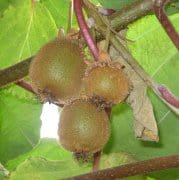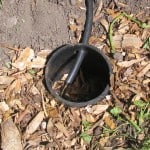Irrigating Plants With Greywater

In general, larger plants, such as trees, bushes, and perennials, are easier to irrigate with simple greywater systems than smaller plants. Turf grass, made up of hundreds of individual plants, is the most difficult to irrigate with greywater- we don’t recommend it. Remember you can safely irrigate any food plant so long as greywater doesn’t touch the edible portion of the plant (no root crops).
Fruit trees
Most fruit trees thrive on greywater, and there are many delicious options! They can tolerate frequent watering and once established they can go long periods with no water.
- Choosing a fruit tree: To start, use root stocks that are resistant to local diseases (ask at your local nursery or Cooperative Extension) and plant trees that are known to grow well in your area. Your tree will also do better if it has good soil; adding compost may be helpful.
- Drainage: Next, consider the drainage of your site. If drainage is poor, you will need to plant the tree on a mound and water it less to prevent diseases like crown rot. When planting trees ensure that the crown of the tree is above the mulch basin to prevent crown rot.
- Salt: Fruit trees are generally salt sensitive and should not be irrigated with water from powdered detergents or other products containing salts. If your greywater source contains lots of salt (dishwasher detergent, for example, is high in salt), add salt-tolerant plants to your landscape, or irrigate frequently with rainwater to flush salts from the soil. Plants that thrive on recycled or reclaimed water (highly treated wastewater) are good choices for high-salt greywater. It’s best to use plant-friendly products, those low in salts and free of boron, to ensure a good quality irrigation water.
Other plants
Other perennials that thrive on greywater include edible shrubs and vines such as raspberries, thimbleberries, blackberries and their relatives, currants, gooseberries, filberts, rhubarb, elderberry, passion fruit, kiwi, hops, and grapes. Blueberries love acidic soil so you’d have to choose pH neutral soaps or use acidic mulch.
Irrigate at the “drip line” of your plants
Plant roots typically extend well past their “drip line,” the outer edge of the branched. Dig the mulch basin at or beyond the drip line and direct greywater into the basin.
Determine how much water your plants want
Design your simple greywater system to direct an appropriate amount of water to each plant; too much could over saturate the soil while too little could dry out the plants. We’ll give you a very rough estimate of how much to water a typical fruit tree during the irrigation season (without rain to supplement). When you design your system make sure to consult further resource, such as The Water-Wise Home or the San Francisco Graywater Design Guidelines for Outdoor Irrigation, to get more detailed instruction on how to determine plant water requirements.
Approximate weekly irrigation needs for a medium sized fruit tree:
- Cool climate: 8-12 gallons/week
- Warm climate: 15-25 gallons/week
- Hot climate: 30-50 gallons/week
The EPA has an on-line calculator to help estimate how much to irrigate in different parts of the country (based on climate).
How to irrigate with greywater
With a simple greywater system, for example a laundry-to-landscape or branched drain system, greywater should be discharged onto mulch (either on the surface or subsurface depending on your state code requirements). Don’t discharge greywater directly onto the bare ground, it can clog the soil by filling the small air gaps in its structure and then won’t drain well. Mulch prevents this potential problem since it filters the particles, enabling greywater to soak into the soil below. Any type of mulch works, like wood chips, straw, or bark.
More complex greywater systems filter greywater so it can be used in greywater-compatible drip irrigation tubing. In these systems the irrigation tubing is used to irrigate the same as in a conventional system and it can be covered with mulch.
With simple greywater systems remember to:
- Discharge onto mulch.
- Have an air space between the pipe and the ground. This will prevent roots from growing back into the greywater pipe and clogging it. In states that require subsurface irrigation a “mulch shield”, such as the irrigation valve box shown in the image, create this air space and prevent clogging.

